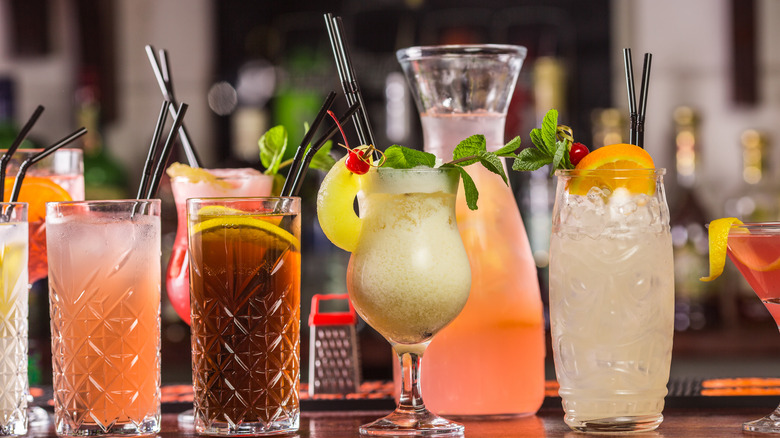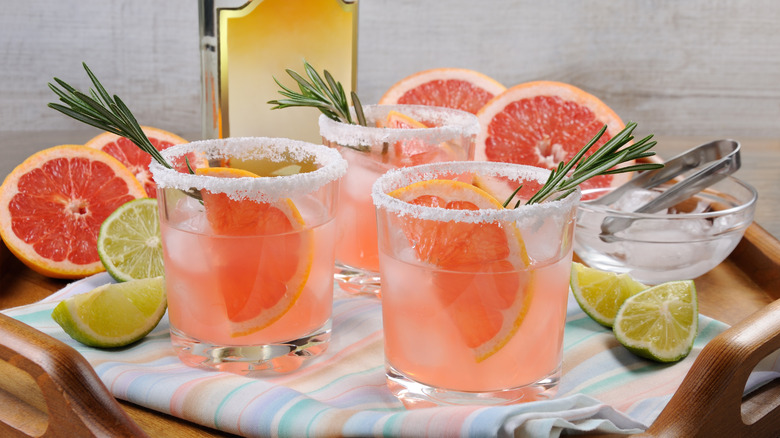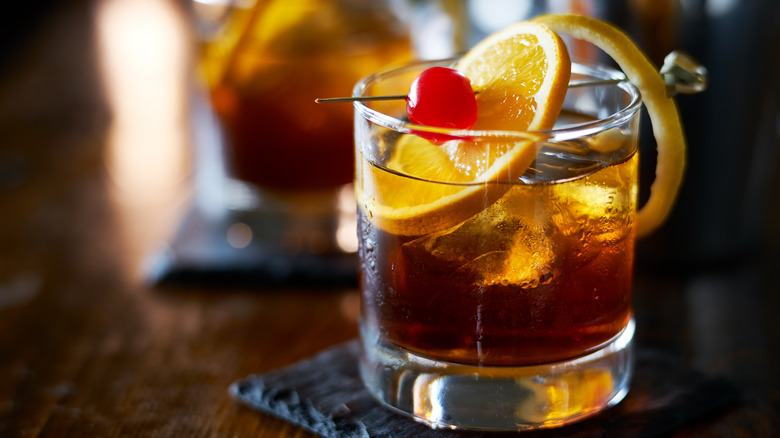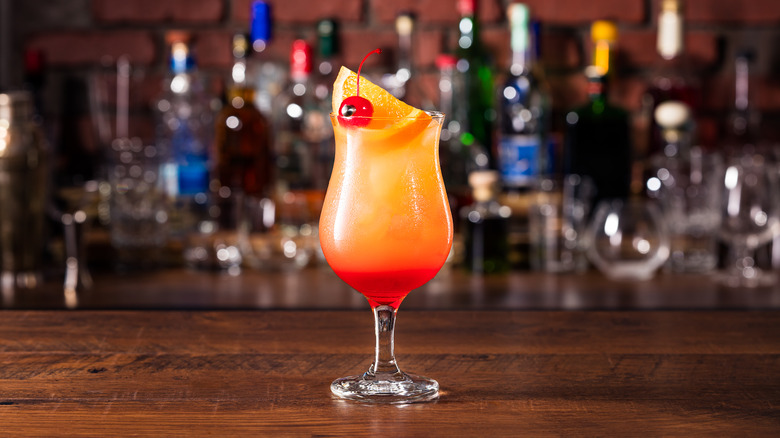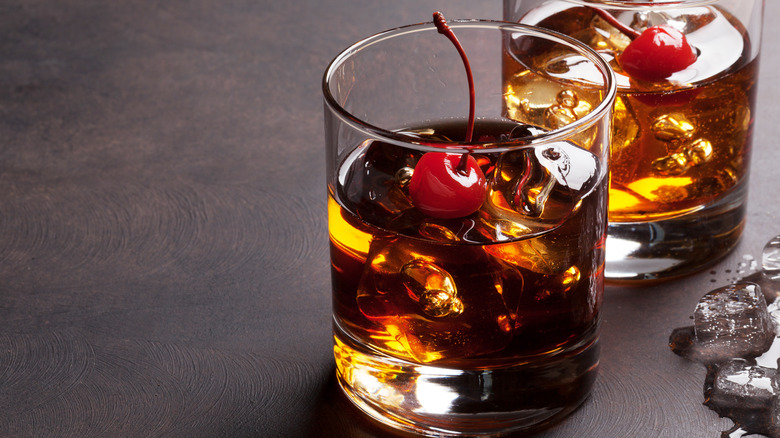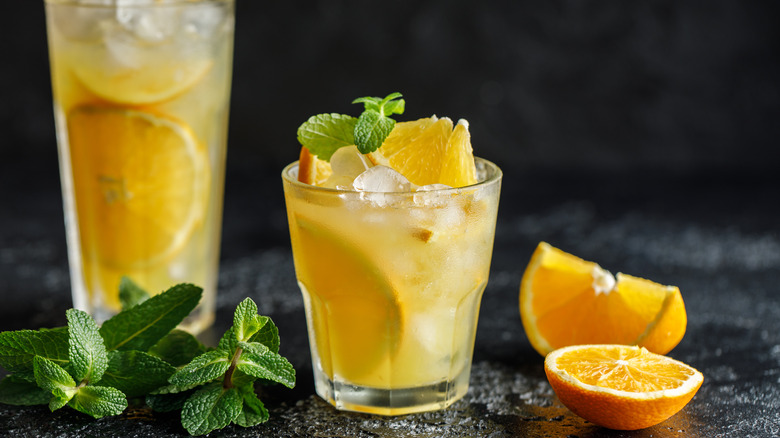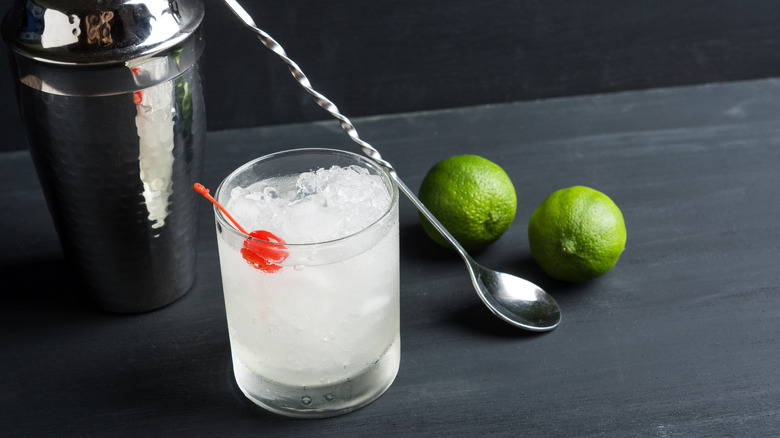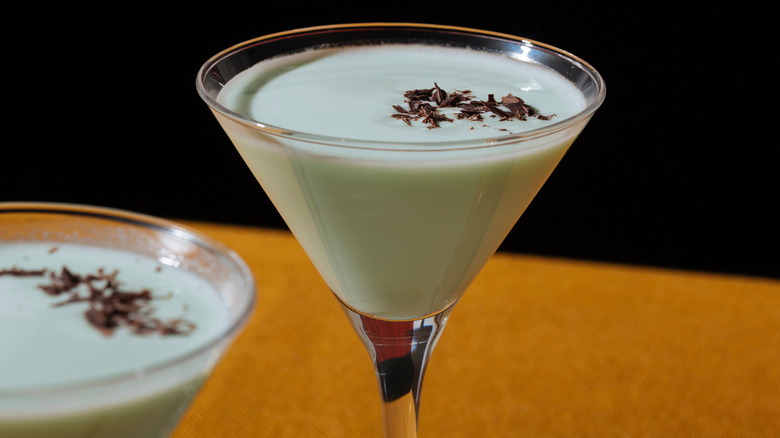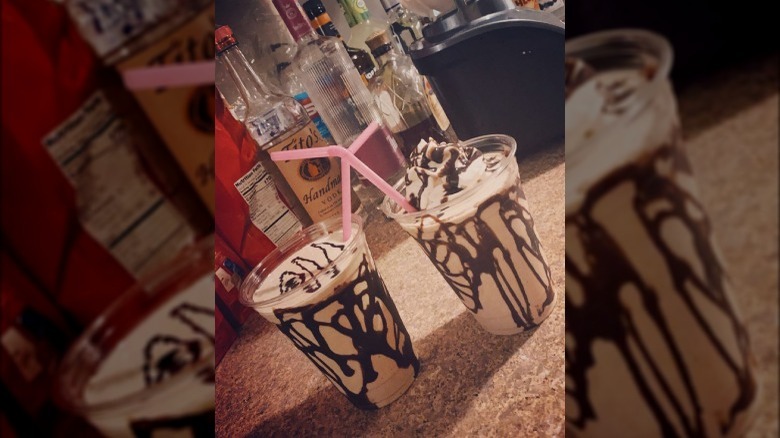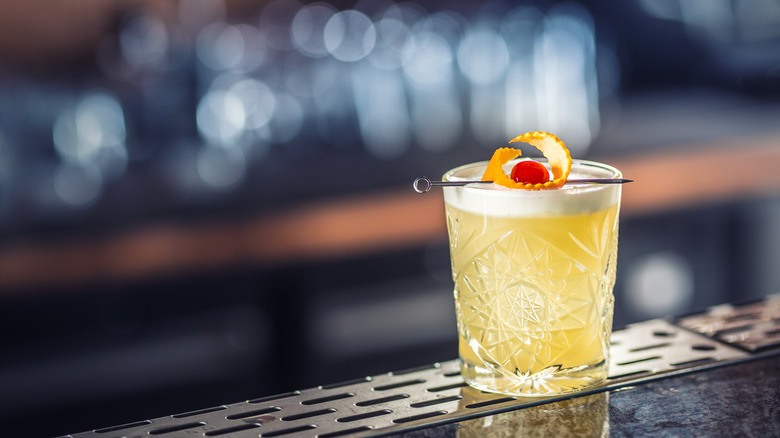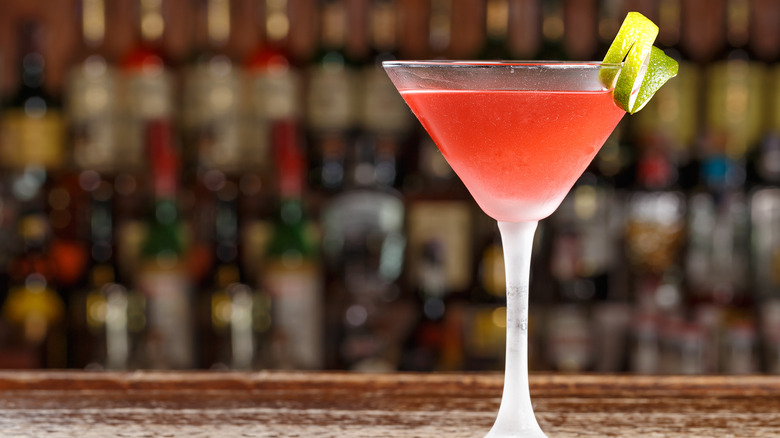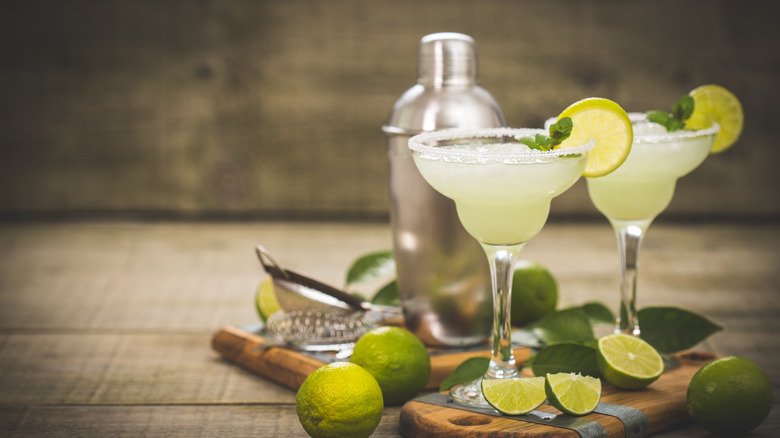The Most Popular Cocktails To Make During Quarantine
Let's be honest: life isn't easy right now. As COVID-19 has spread across the world, millions of people have been forced into lockdowns and quarantines. Many of us are holed up in tiny apartments with no yards. Many are separated from friends and family, with our only method of communication being via video conferencing apps. Some are even stranded in unfamiliar places, with no real way of telling when we'll be able to get home again.
So yeah — bad times. Hopefully, however, many of us have found our own ways of coping. Maybe you're throwing yourself into your work, if you're lucky enough to do that. Maybe you're occupying yourself with your family. Maybe you're reading, or binge-watching, or creating. Or maybe — and no judgement, here, seriously — you're punctuating your days with a drink or two.
That's certainly true for many households across America, and in May 2020, Google released a number of statistics regarding people's cocktail-based searches during the pandemic. Now, thanks to this report, we can pinpoint which states are loving which cocktails. From old classics to unexpected wildcards, these are the most popular cocktails of all. Cheers.
Paloma
We begin with the Paloma, which has so far been the cocktail of choice in Arizona, California, and Texas — all states which sit along the Mexican border. And that might not come as too much of a shock, considering the drink's background.
Although the exact origins of the Paloma are a little murky, according to Taste Cocktails, some believe that it was created by Don Javier Delgado Corona, who was the owner and bartender of La Capilla, one of the oldest bars in Tequila, Mexico. It's said that the cocktail is named after La Paloma (which literally means "The Dove"), a popular Mexican folk song composed in the 19th century.
In case you're unfamiliar with this drink, the Paloma is essentially Tequila and grapefruit juice. Shake two ounces of Tequila, four ounces of grapefruit juice, half an ounce of squeezed lime juice in a cocktail shaker with ice. Pour the mixture into a glass filled with ice cubes, and top it up with grapefruit soda. Throw on a little garnish of lime, and voila — pure refreshing summer joy; and the perfect drink for beating the heat in those Mexico-adjacent states.
Unfortunately, there may in fact be another reason for the Paloma's current popularity. In March 2020, the supposed creator of the drink, Don Javier, died at the age of 95. Incredibly, he had been bartending for 75 of those years.
Old-fashioned
The old-fashioned has got to be one of the world's most famous cocktails — so it's little surprise that it's so popular in so many states. According to Google's report, the old-fashioned is the most-searched cocktail in as many as seven different states: Massachusetts, Nebraska, New Hampshire, New Mexico, Oregon, Virginia, and Washington.
The origin of the old-fashioned can be connected to the first use of the word "cocktail," which dates back to at least 1806, when the term was used in The Balance, and Columbian Repository, a New York newspaper. The editor of the paper called for cocktails to be made up of spirits, sugar, water, and bitters, which is remarkably close to what we know as the modern old-fashioned. Back then, however, the term "old-fashioned" was used to describe the earliest ways in which cocktails were made; in this sense, you could have a rum old-fashioned or a tequila old-fashioned. Before long, the term had become synonymous with the whiskey version of the drink.
Liquor.com's recipe for the old-fashioned is easy enough: Add half a teaspoon of sugar, three dashes of Angostura bitters, and a teaspoon of water into a glass with rocks, then stir until the sugar is dissolved. Then fill the glass with ice cubes, add two ounces of bourbon, and gently stir to combine. Express the oil of an orange peel over the glass, then drop it in to garnish. Easy — and proof that, sometimes, the old ways are the best.
Hurricane
The Hurricane is another repeat occurrence on Google's list of state cocktails, making appearances at the top of the list in both Alabama and Colorado. Honestly, we can't make much of a connection between these states and the Hurricane, since the cocktail's history derives from other places entirely.
A few versions of the Hurricane's origin exist, but the most popular stems from the Deep South.
This version of the tale posits that the Hurricane was first created at Pat O'Brien's, a legendary bar in the French Quarter of New Orleans. According to this story, there was a surplus rum supply in the wake of World War II (which had seen bourbon and Scotch stocks run down), and barrels of the stuff were pouring into New Orleans via both the Mississippi and the city's port.
In order to shift all that rum, distributors forced bars to buy multiple cases in exchange for a case of whiskey. To help sales along, Benson O'Brien and his partner concocted the Hurricane. A 1956 recipe was published in Cabaret magazine by O'Brien's head bartender Louis Culligan, who some claim was the drink's real inventor. This recipe called for four ounces of gold rum, two ounces of lemon juice, and two ounces of Fassionola passion fruit syrup to be added to ice and shaken hard, then poured, unstrained, into a large Hurricane glass. Thanks in particular to the striking glass in which it was served, the Hurricane quickly became one of the city's signature cocktails.
Manhattan
You can probably guess where this one is popular. Google's analytics have the Manhattan coming top of the list in New Jersey, Illinois, and — shocker — New York itself.
This vermouth-based cocktail was, in fact, one of the first to use vermouth in its recipe. According to Liquor.com, it's likely that the Manhattan first appeared in the 1880s, meaning it predates other vermouth cocktails such as the martini, the Rob Roy, and the Bobby Burns.
Now, the Manhattan Club in New York does make a claim to being the birthplace of the drink, with popular legend suggesting it was created for a party thrown in 1874 for Jennie Jerome, future mother to Winston Churchill. Considering Lady Churchill was in England at that time, however, it's likely the legend is more of a myth.
But Liquor.com has traced the Manhattan's story to another source: a bartender named William F. Mulhall, who worked at the Hoffman House in New York from the early 1880s. By his account, "The Manhattan cocktail was invented by a man named Black, who kept a place ten doors below Houston Street on Broadway in the [eighteen-] sixties."
You can make a Manhattan for yourself by stirring two ounces of rye whiskey, one ounce of Italian vermouth and two dashes of Angostura bitters together with cracked ice, then straining into a chilled cocktail glass. Garnish with a twist or a cocktail cherry, then sit back and enjoy. Black would be proud.
Screwdriver
The cocktail of choice for errant teens who have managed to successfully raid their parents' stash of booze (note: don't do that, teens), the screwdriver is one of the simplest cocktails out there. Indeed, this might be the reason it has become so popular during lockdown, having made the top spot in Delaware, Kansas, and South Dakota.
As with so many other cocktails, the screwdriver has conflicting origins. One story suggests the recipe began during World War II, when American marines would liven up their orange juice with vodka. A 1944 account gives credit to the recipe to interned American fliers. Yet another version attributes the drink's origin to American oil workers in the Persian Gulf during the mid-20th century. In order to cope with their dangerous work and long hours, they too would mix vodka into orange juice — but since they had nothing to stir it with, they were forced to use their screwdrivers.
Wherever it came from, there's no denying that this isn't the most difficult cocktail to mix. Simply add one and a half cups of orange juice and a cup of vodka into a pitcher, and pour over ice. Make sure you're using decent vodka and fresh orange juice, while keeping things cold — or this one might come out less "summer refreshment" and more "horrifying first gulp of liquor at a young age".
Kamikaze
The Kamikaze is, according to Google's analytical report, the lockdown drink of choice for Idaho, Iowa, Maryland, North Dakota, and West Virginia.
Despite the connotations of its name, the Kamikaze originated in neither Japan nor during World War II. According to cocktail historian David Wondrich (via First We Feast), the Kamikaze first appeared on the disco scene sometime around 1976.
In his 1984 book Cocktail, the American screenwriter Heywood Gould dives a little deeper into the drink's history. "The Kamikaze is one of the classic disco cocktails invented by barbiturated teenagers," he writes. "It's a senseless, infuriating concoction made of equal parts vodka, lime juice, and triple sec... There are no standards for the Kamikaze. It has no particular attributes that would distinguish a good kamikaze from a bad one, like a dry martini or a tart gimlet. It exists merely to confer a little cache on these pimpled baboons."
Not exactly a glowing review for the good people of Idaho, Iowa, Maryland, North Dakota, and West Virginia there, but hey, times have changed. Luckily, even the most pimpled of baboons should be able to mix their own Kamikaze. Squeeze three-quarters of an ounce of strained lemon juice into a shaker with ice, add two ounces of vodka, and three-quarters of an ounce of orange liqueur or triple sec. Shake vigorously for 20 seconds, then pour into a martini glass. Garnish with some fruit, throw on a little KC and the Sunshine Band, and dance your lockdown woes away.
Grasshopper
While not quite as popular as some of the others out there, the Grasshopper nonetheless comes up as the favorite quarantine cocktail in Wisconsin and Nevada. Famed for its minty green appearance and sweet flavor, this drink is, according to Eater, popular among new drinkers and nostalgia-filled old folks alike. As Mark Latter, owner of New Orleans bar Tujague's, tells the publication: "It's not a really strong drink, so if you give your 9-year-old a sip of this mint chocolate chip drink, it's not like giving them a sip of bourbon." Although, obviously, don't do this.
The Grasshopper actually originates in Tujague's, which opened in the French Quarter in 1856. The story goes that the bar and restaurant's owner, Philibert Guichet, invented the Grasshopper on a trip to New York for a cocktail competition. Having won second prize for the recipe, he brought it back to NOLA. The recipe is usually simple enough: Add three quarter ounces of green creme de menthe, white creme de cacao, and light cream, into a shaker, then shake and strain into a cocktail glass and garnish with mint.
Curiously enough, the Grasshopper is also closely associated with Wisconsin supper clubs, and Portland mixologist Jeffrey Morgenthaler credits that state's bartenders for getting him into Wisconsin's version of the Grasshopper — which involves serving it as a blended dessert drink that utilizes ice cream in its recipe. No wonder it's popular there right now.
Bushwacker
The favorite quarantine cocktail in Louisiana and North Carolina, the Bushwacker is what Esquire describes as a "chocolate Piña Colada milkshake". The cocktail dates back to 1975, when it was invented and sold at the Ship's Store and Sapphire Pub on St. Thomas, in the U.S. Virgin Islands. The drink was created by Angie Conigliaro and Tom Brokamp, the latter of whom was the Ship's Store's manager. Brokamp and Conigliaro decided to name their cocktail after a guest's dog, whose name was Bushwack. By the end of 1975, the recipe had spread to the U.S. mainland, where it was sold at the Sandshaker Lounge in Florida. Today, it's a staple cocktail for beach loungers and tropical relaxation.
Different places tend to have slightly different Bushwacker recipes. For example, the U.S. Virgin Islands version differs slightly from that Floridian version sold at the Sandshaker Lounge. But let's go for the original here, for the sake of enjoying a little history. You'll need half an ounce of each of these ingredients: vodka, Bailey's, coconut rum, Kahlua, amaretto, and dark rum. Blend them all together with three quarters of a cup of crushed ice, and pour the mixture into a tall glass with chocolate syrup lining the inside edges. Add a cherry as garnish, and serve straight up — with whipped cream, if you'd prefer, which let's face it: you would.
Whiskey sour
Alaska and Pennsylvania are necking back the whiskey sours during quarantine, it appears. The recipe for this simple whiskey-based cocktail has existed since the 18th century, when it was used as a drink for sailors making long sea voyages. At the time, water was rarely considered safe to drink, and food would often spoil during the time it took to traverse the ocean. To combat this problem, the Royal Navy's Vice Admiral Edward Vernon began using the rations found on ships to concoct a drink his sailors could enjoy. Lemons and limes were in abundance, to help prevent scurvy, so it was added to liquor (rum, at that point) and served on board Vernon's ships.
These sailors then brought the recipe back to shore. For the English, the rum was usually swapped out for gin or brandy, but Americans tended to prefer whiskey, since it was easier to get hold of. In 1862, a writer named Jerry Thomas codified the recipe in The Bartender's Guide, and the whiskey sour only grew in popularity from there.
These days, you can make a whiskey sour with about a couple of ounces of whiskey, an ounce of lemon juice, and half an ounce of syrup. Add the ingredients to a shaker over ice and shake hard, then strain into a glass filled with ice, and garnish with a slice of lemon, lime, or orange. Drink near the sea.
Cosmopolitan
Queen of the cocktails in Michigan, Rhode Island, and Vermont, is the Cosmopolitan. A favorite drink among the LGBT community, celebrities, and Carrie Bradshaw alike, the Cosmo's origin can likely be traced to Toby Cecchini, of the Odeon in Manhattan. Similar drinks had existed prior to the 1980s, including the Kamikaze and the Harpoon, but the Odeon is often regarded as the cradle of the modern Cosmopolitan. In 1987, Cecchini's co-worker Melissa Huffsmith introduced him to a similar drink that used Rose's Lime Cordial in its recipe. Cecchini shook the recipe up a little and used Absolut Citron, Cointreau, cranberry juice, and fresh lime juice.
Cecchini's Cosmpolitan took off, and became an icon of pop culture when it was featured regularly on "Sex and the City." Throughout the late '90s and early '00s, it became one of America's most popular cocktails.
All you need to do to make your own is combine one and a half ounces of citrus vodka, half an ounce of Cointreau, an ounce of cranberry juice, and a quarter ounce of fresh lime juice, then shake well and strain into a chilled Martini glass. Garnish with an orange twist and argue for three hours about whether you're a Carrie or a Samantha.
Margarita
Finally, we've got margaritas. Funnily enough, the border states seem to be too preoccupied with their Palomas to get their margaritas on, and these iconic cocktails actually top Google's list in Connecticut and Maine.
Same as it ever was, with the margarita's beginnings — it's hard to really pin down the true story. According to one story, the cocktail was created in 1938, when Mexican restaurant owner Carlos Herrera came up with it in order to impress Marjorie King, an actress and showgirl of the time. Another story credits Texan socialite Margaret Sames with the drink's invention, claiming it was mixed by her at a house party in Mexico in 1948. Yet another story goes that it was named for actress Rita Hayworth, whose real name was (the far cooler) Margarita Casino. The truth is, nobody's really sure where it came from. It's at least thought that, according to David Wondrich, the drink evolved from another cocktail known as the Daisy, which mixed alcohol, citrus juice, and grenadine, over shaved ice. It's definitely worth noting that "margarita" is the Spanish word for "daisy."
Either way, this one's not too tricky. Moisten the rim of a rocks glass with a wedge of lime, then roll the glass in salt. Combine two ounces of blanco Tequila, one ounce of orange liqueur, and an ounce of lime juice in a shaker filled with ice. Shake and strain into the glass, over fresh ice. Happy days.
